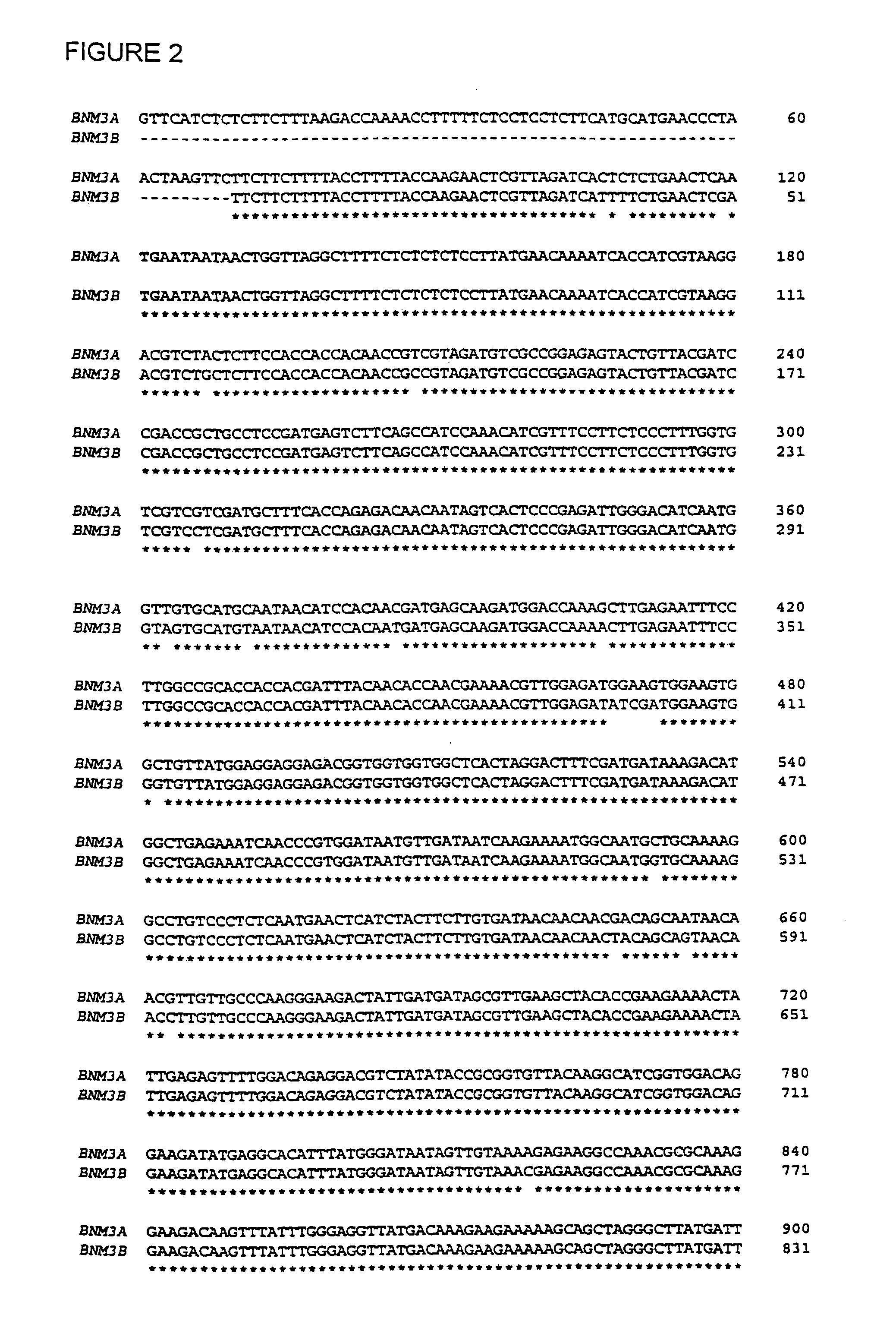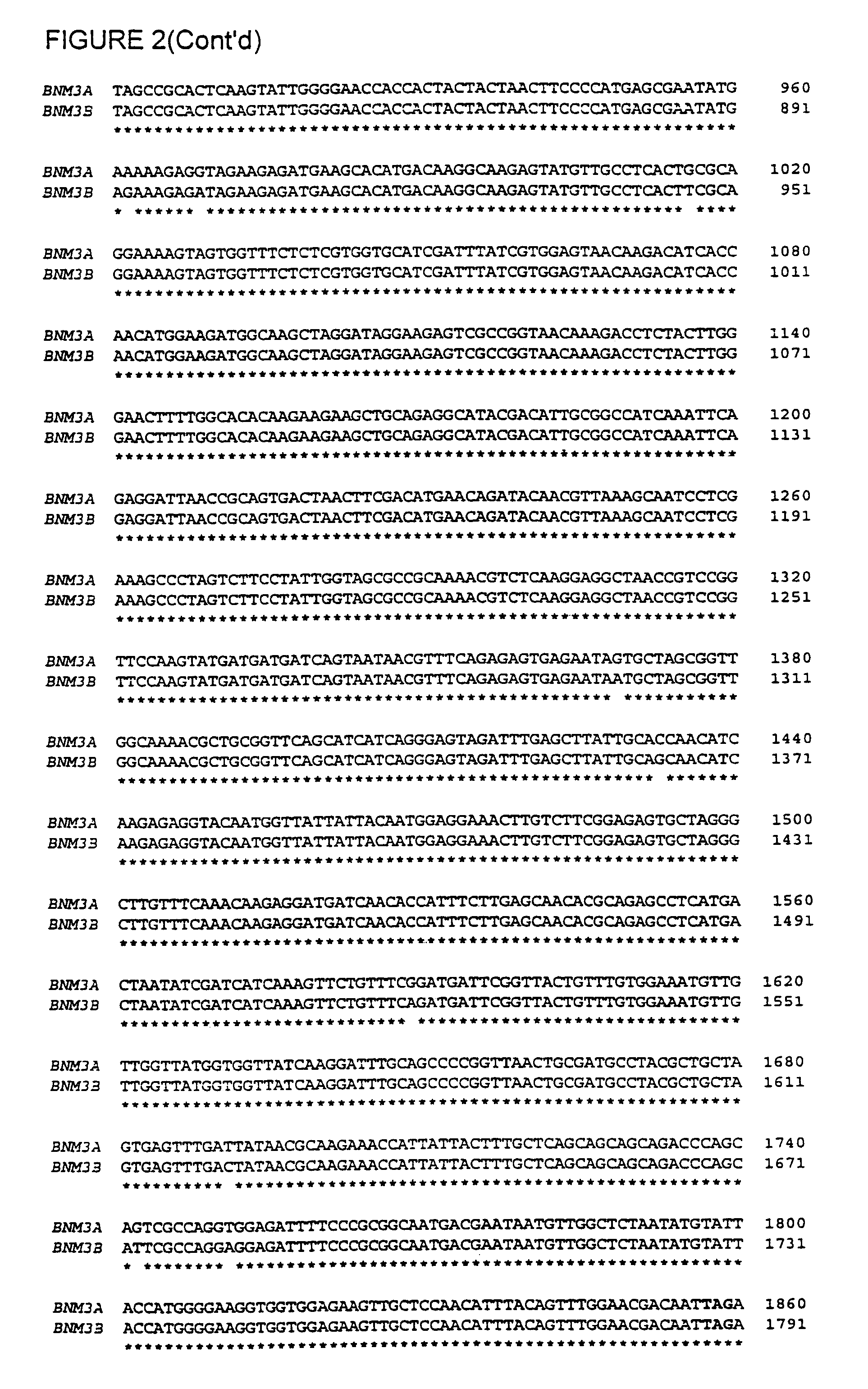Use of the BNM3 transcriptional activator to control plant embryogenesis and regeneration processes
a technology of plant embryogenesis and transcriptional activation, which is applied in the direction of biochemical apparatus and processes, peptide sources, organic chemistry, etc., can solve the problems of not leading to methods for routine production of apomictic plants, labour-intensive and costly procedures, etc., and achieves the effect of increasing the regenerative capacity of the plant cell
- Summary
- Abstract
- Description
- Claims
- Application Information
AI Technical Summary
Benefits of technology
Problems solved by technology
Method used
Image
Examples
example 1
Isolation and Characterization of the BNM3 Genes from Brassica Napus
[0207]A subtractive screening approach was used to isolate genes preferentially expressed during the induction of Brassica napus c.v. Topas microspore embryogenesis (FIG. 1). Two types of microspore cultures were used in the construction of a subtracted probe: embryogenic and non-embryogenic. Embryogenic cultures were obtained by subjecting late uninucleate microspores and early binucleate pollen to a 4 day, 32° C. heat stress treatment. The non-embryogenic sample was obtained by culturing the same starting population of late uninucleate microspores and early binucleate pollen for 1 day at 25° C. followed by 3 days at 32° C. (Pechan et al., 1991). Poly(A) mRNA was isolated from the embryogenic sample and used to synthesize first strand cDNA. The cDNA was then hybridized to an excess of poly(A)+ RNA isolated from a non-embryogenic microspore / pollen sample. The non-hybridizing, single stranded cDNA, enriched for sequ...
example 2-1
The BNM3 Genes Encode New Members of the AP2 Domain Class of Transcriptional Activators
[0208]A single BNM3 cDNA clone, BNM3A, was isolated after screening an embryogenic microspore cDNA library with a subtracted probe enriched for genes expressed in embryogenic microspores and pollen. The discrepancy between the size of the cDNA clone (1.2 kb) and the size of the transcript detected on RNA gel blots (2.2 kb) indicated that this clone did not represent a full-length cDNA. Two longer cDNA clones, corresponding to the full length cDNA of the clone originally isolated, BNM3A (SEQ ID NO. 1), and a new clone, BNM3B (SEQ ID NO. 3), were isolated from a 10 day old Brassica napus microspore embryo cDNA library. The alignment of the DNA sequence of these clones is shown in FIG. 2. The two BNM3 cDNA clones are 2011 and 1992 nt in length, and are 97% similar at the nucleotide level, differing only slightly in the length and sequence of their 5′ and 3′ untranslated regions. Both cDNAs potentiall...
example 2 — 2
Example 2—2
The Brassica Napus BNM3 Genes are Represented by a Single Arabidopsis Thaliana Orthologue
[0215]DNA gel blot analysis of arabidopsis genomic DNA hybridised to a number of Brassica napus BNM3A cDNA (SEQ ID NO:1) probes under conditions of low and moderate stringency indicated the presence of a single homologue of the Brassica napus BNM3 genes in the arabidopsis genome. An RFLP was also identified between ecotypes Columbia and Landsberg erecta using the Cfo I restriction endonuclease. This RFLP was used to map the position of the single BNM3 homologue on the arabidopsis genome to approximately 34 cM on chromosome 5 (Lister and Dean 1993).
[0216]Screening of three genomic equivalents of an arabidopsis genomic library identified three Lambda clones containing the putative full length arabidopsis BNM3 homologue (AtBBM). Sequence analysis of the three AtBBM clones indicated that they are identical (SEQ ID NO:6). FIGS. 9A and B show respectively the restriction fragment pattern of...
PUM
 Login to View More
Login to View More Abstract
Description
Claims
Application Information
 Login to View More
Login to View More - R&D
- Intellectual Property
- Life Sciences
- Materials
- Tech Scout
- Unparalleled Data Quality
- Higher Quality Content
- 60% Fewer Hallucinations
Browse by: Latest US Patents, China's latest patents, Technical Efficacy Thesaurus, Application Domain, Technology Topic, Popular Technical Reports.
© 2025 PatSnap. All rights reserved.Legal|Privacy policy|Modern Slavery Act Transparency Statement|Sitemap|About US| Contact US: help@patsnap.com



